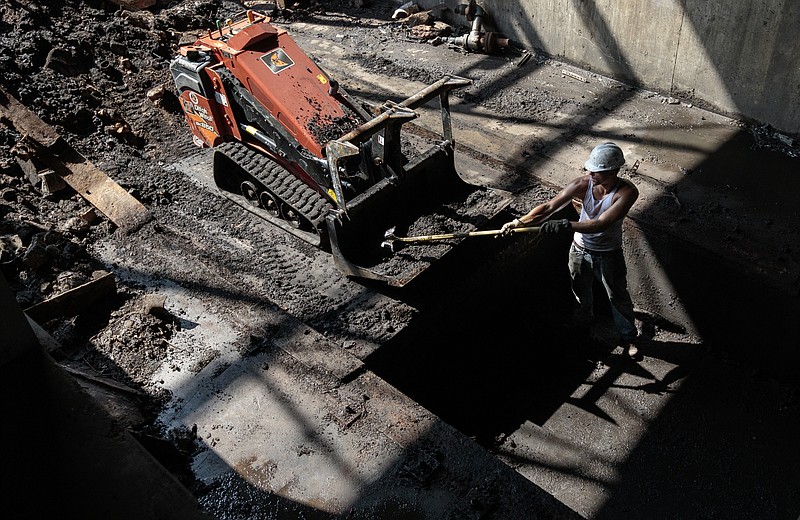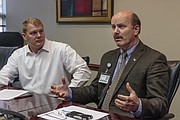Photo Gallery
Cutting carbon and costErlanger hopes to be energy showcase with heat recovery project
Erlanger Health System is building a $13 million natural gas-fired energy system at its main campus which hospital officials believe will be a showcase project for cutting energy, expenses and pollution.
Chattanooga's biggest hospital plans to install the 8-megawatt Combined Heat and Power facility next year in a former incinerator building to generate most of the electricity and most of the hot water consumed in the 2.5-million-square-foot medical complex on East Third Street.
The Tennessee Valley Authority is providing $6.75 million to match the hospital's investment under a green energy pilot program designed to encourage more efficiency through combined heat and energy facilities.
"This is kind of perfect model for a CHP (combined heat and power) plant because we will be able to reduce emissions, create a more reliable energy source for the hospital with on-site generation and also save us a great deal of costs on our overall energy bill," said John Loetscher, vice president of facilities, engineering and real estate at Erlanger who has been working on the project since shortly after he arrived at Erlanger in 2015.
Loetscher estimates the new energy system should help Erlanger save more than $1 million a year on the roughly $5 million of annual energy expenses for the main campus to heat, cool and power the hospital and adjacent medical offices. With the aid of TVA in the pilot program, Erlanger's investment should pay off in less than four years.
Since hospitals use a lot of steam and hot water around the clock, such facilities are ideal to capture the excess steam and heat generated in a power plant that produces steam to turn turbines to make electricity. The idea behind combined heat and power, or co-generation, is to capture the heat that would normally be wasted in electricity generation and supply it to local buildings as well. Where a conventional power plant makes electricity and wastes the heat it makes as a byproduct, a CHP power plant makes both electricity and hot water and supplies both to consumers.
At a glance
› Project: Combined Heat and Power plant.› Investment: $13 million, incuding $6.75 milion incentive from TVA.› Capacity: 8 megawatts.› Manufacturer: 2G Energy Inc., which will make the package units in St. Augustine , Fla.› Location: The new equipment will be placed in the former Erlanger incinerator across Blackford Street from the hospital next to the central energy plant.› Schedule: Design and building will take about two years. The system should be operational by mid-2018.Source: Erlanger Health System
The new system is designed to achieve as much as an 80 percent efficiency, which is nearly double what some traditional power plants get from burning fossil fuel, making steam to make electricity and then distributing that power over long distances.
"We hope this can not only save energy and money but be a real showcase to demonstrate the potential of distributed energy," said Ben Edgar, president of White Harvest Energy, a 3-year-old Chattanooga company that has worked with Erlanger and TVA to plan and develop the project. "Chattanooga is already known for its smart grid and we hope this can be a model for others as well. We're going to be one of the highest efficiency CHPs (combined heat and power units) and the modular nature of it is also groundbreaking."
By having its own generation, Erlanger also expects an extra layer of reliability to its power supply, which already has multiple connections with EPB, the local TVA power distributor, and its own diesel-fired generators for power in the event of an electrical blackout.
Currently, there are 224 hospitals in the United States with combined heat systems. Since hospitals operate continuously and use both heat and electricity at all times, health care facilities are an attractive site for combined heat and power systems, which are also becoming more popular as distributed energy, or self-generation, becomes more popular to ensure the reliability of power supplies.
The design and building of the new facility is taking about two years. The four generating modules, each of which is 55-feet long, 10-feet wide and 12-feet high, will be installed in a building once used as the hospital's incinerator before it was shut down nearly two decades ago.
"By this time next year, we hope to be generating electricity with the new equipment," Edgar said.
The project includes four modular natural gas, combined heat and power units to be made by 2G Energy Inc., a German-based company that will produce the equipment at its plant in St. Augustine, Fla.
Loetscher said because of the greater efficiency of the new system there is much energy loss with the current system, including pollutants going into the air. He said switching to the new plant will reduce carbon dioxide emissions by 20 million pounds a year, or the equivalent of taking 2,200 cars off the road or planting about 400,000 trees or a 650-acre oak forest.
"We think this is the right project at the right time to lower our costs and to be more 'green friendly,'" said Gregg Gentry, chief administrative officer for Erlanger. "Hospitals are a huge utilizers of energy so these type of projects where we can gain some efficiency and energy savings can be a real benefit for everyone."
Contact Dave Flessner at dflessner@timesfreepress.com or 423-757-6340.

